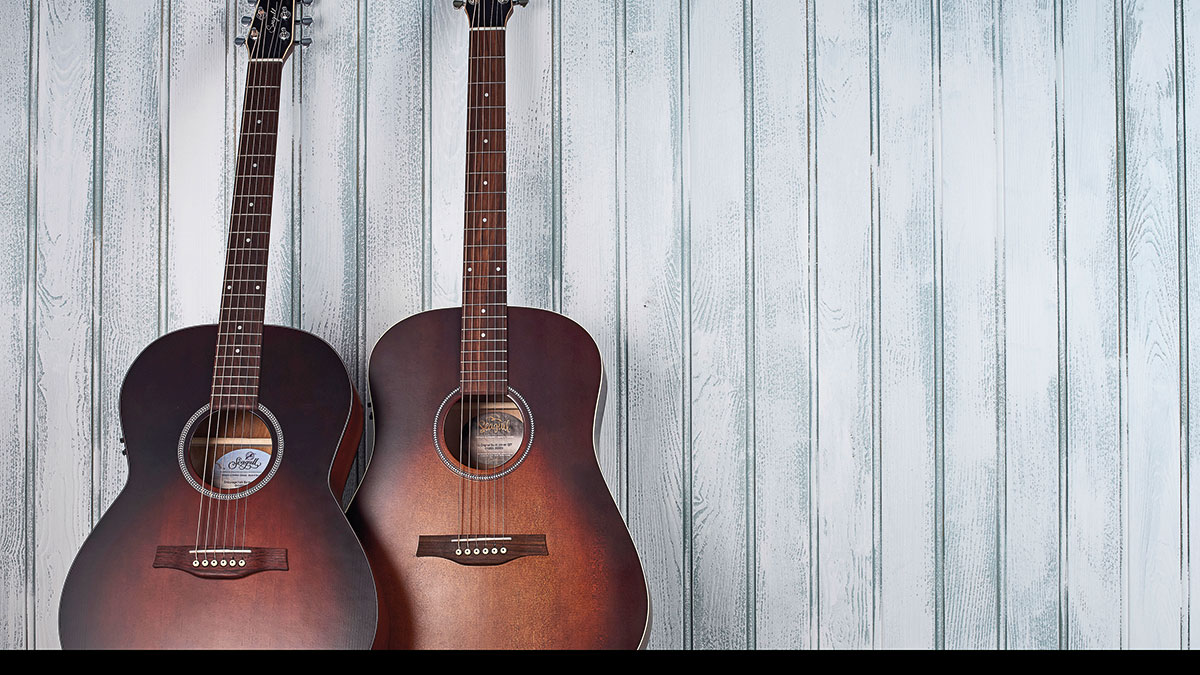MusicRadar Verdict
Sound-wise there's plenty of old-style charm here, especially if you're unmoved by the overly modern, crystalline sound of numerous electros, especially amp'd.
Pros
- +
Forward thinking but with retro charm.
Cons
- -
Very few.
MusicRadar's got your back
For 2016, Godin's Seagull range is going through a brand refresh.
Along with new models - and they're all electros this year - there's a new colour (Burnt Umber, as seen here), a new under-saddle pickup, new tuners and a bolder logo with a different forward-looking seagull. You can see this logo on the S6's headstock.
So, our S6 dreadnought is bang up to date and the first Seagull to have all these new bits.
It's a 14-fret design with a 648mm (25.5-inch) scale, solid cedar top (with Adirondack spruce bracing), laminated wild cherry back and sides, rosewood fingerboard, silver leaf maple neck and Graph Tech Tusq nuts and compensated saddle.
The S6's 'burst continues to the neck sides and back, offset by single-ply cream binding. Detailing is crisp, inside and out, and the satin finish is clearly very thin. Decoration is minimal, just a slightly different herringbone soundhole motif and simple dot inlays on both 'boards.
The S6's tuners are new-spec with quite a retro-looking Seagull script logo'd back casing.
The electronics have been upgraded, too, for this year with a new EPM-designed under-saddle pickup, while the small Q1T side-mounted preamp offers a tuner plus volume, and treble and bass controls, sadly without centre detents.
Sounds
String spacing at the bridge is 54mm, while the neck shape is fairly full-depthed (20.5mm at the 1st, 24mm at the 9th fret) but with quite tapered shoulders, making your hand believe it's thinner than it really is.
As befits its size, the S6 dreadnought kicks out some volume played acoustically with quite a boisterous 'hello, I'm here' character. What's special about it is quite a unique voice, the combination of those laminated wild cherry back and sides, which, says Godin, has "a sound that lands somewhere between the mellow tone of a mahogany guitar and the bright sound of maple", with the cedar top plus a robust but pretty light build.
It feels, and sounds, obviously, new and a little tight but should hopefully fill out and mellow a little with playing. As is, there's quite a strident tonality and, as we've noted before, a hint of acoustic archtop that perhaps suits rootsier and bluesier styles more than pristine, crystalline modern voicings.
Amplified, the EPM system is nicely voiced. The bass EQ is quite strong, so use with care, and a little treble reduction tames the new-string brittleness. Yes, there's a slight piezo character, but it's far from thin and quacky where we'd be tempted to blend in a magnetic soundhole pickup to maximise that older tonality.
While this new finish creates a very old-school vibe, Seagull's modernistic headstock probably won't appeal to vintage aficionados. Yet the mismatch signifies exactly where Seagull is aimed: forward looking but with pretty classic roots.
Dave Burrluck is one of the world’s most experienced guitar journalists, who started writing back in the '80s for International Musician and Recording World, co-founded The Guitar Magazine and has been the Gear Reviews Editor of Guitarist magazine for the past two decades. Along the way, Dave has been the sole author of The PRS Guitar Book and The Player's Guide to Guitar Maintenance as well as contributing to numerous other books on the electric guitar. Dave is an active gigging and recording musician and still finds time to make, repair and mod guitars, not least for Guitarist’s The Mod Squad.

"I believe I’ve got the last recording Jeff Beck ever did in the studios": Guitarist Mick Rogers thinks he's in possession of a piece of musical history

“If you want a good vocal, you gotta drink snake sperm”: Singer Jessica Simpson reveals the unusual drink that keeps her vocal cords in tip-top condition

“I was thinking at the time, if anyone wants to try and copy this video, good luck to them!”: How ’60s soul music, African rhythms and a groundbreaking video fuelled Peter Gabriel’s biggest hit











